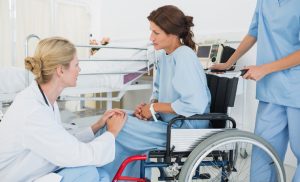 Bladder problems in people with spinal cord injuries can be improved with training and epidural stimulation. People who have suffered spinal cord injuries are often prone to bladder infections, which can progress to kidney damage and even death.
Bladder problems in people with spinal cord injuries can be improved with training and epidural stimulation. People who have suffered spinal cord injuries are often prone to bladder infections, which can progress to kidney damage and even death.
The UCLA researchers studied 10 paralyzed rats that were trained for six weeks with epidural stimulation and five rats that were untrained and did not receive the stimulation. Epidural stimulation was found to enable the rats to empty their bladders more fully and in a timely manner, compared to the rats that did not receive the stimulation.
Advertisement
Senior author of the study V. Reggie Edgerto said, “The big deal here is the immediate effect. There may be a way that when people have bladder problems, you can turn the stimulator on and they can release urine at will. This strategy could have a major impact in improving the quality of life and longevity of human patients.”
“We’re not saying it will restore this part of their lives to normal, but we think it will lead to a significant improvement in quality of life,” Edgerto added.
The researchers also found that the rat was able to release urine within 90 seconds after they filled the rat’s bladder with saline solution and turned on the epidural stimulation.
Edgerto believes there is a connection between neural networks that control walking and bladder function. This may explain why bladder problems are more prevalent among those with spinal cord injuries.
Edgerto concluded, “The circuitry in the spinal cord is remarkably resilient. Once you get them up and active, many physiological systems that are intricately connected and that were dormant come back into play.”
Treatment options for bladder problems in people with spinal cord injuries
As mentioned, bladder problems are common in people with spinal cord injuries. The condition is known as neurogenic bladder, or neurogenic bowel if it affects the bowel. Signs of neurogenic bladder include loss of bladder control, inability to empty the bladder, urinary frequency, and urinary tract infections.
The good news is, there are treatment methods to ease the effects of a neurogenic bladder after a spinal cord injury, but the first step is to talk to your doctor about your concerns.
One of the treatment options for bladder problems in spinal cord injuries is clean technique intermittent catheterization, a procedure in which a catheter is inserted through the urethra to the bladder and empties your bladder several times a day. Another treatment is known as continuous catheter drainage, which involves continuously emptying the bladder through a catheter during the day.
Advertisement
Your doctor may also choose to perform bladder reconstructive surgery, which may either improve or completely resolve bladder problems in spinal cord injury.
Lastly, certain prescription medications may help to improve bladder function.
It’s important that you talk to your doctor about your bladder problems so they are aware of your issues and can suggest an appropriate treatment.
